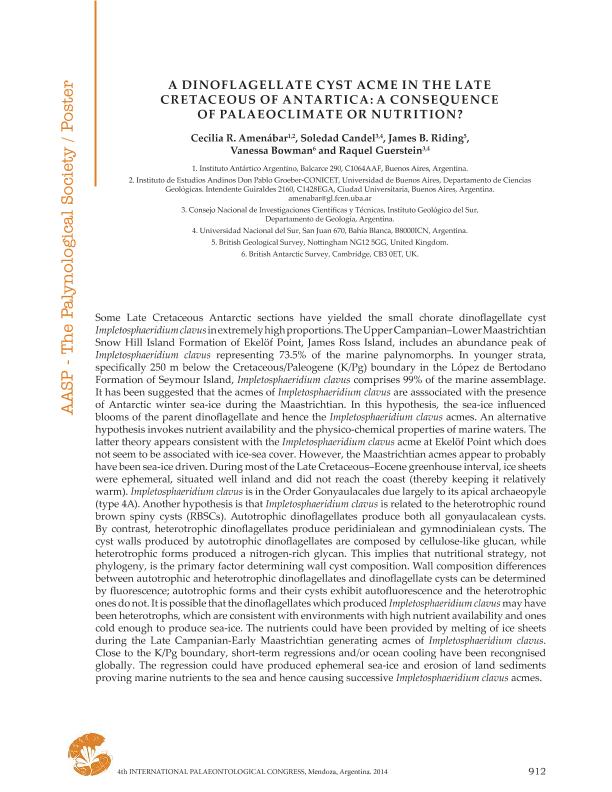Mostrar el registro sencillo del ítem
dc.contributor.author
Rodriguez Amenabar, Cecilia

dc.contributor.author
Candel, Maria Soledad

dc.contributor.author
Riding, James

dc.contributor.author
Bowman, Vanessa
dc.contributor.author
Guerstein, Gladys Raquel

dc.date.available
2023-12-04T10:21:23Z
dc.date.issued
2014
dc.identifier.citation
A dinoflagellate cyst acme in the late Cretaceous of Antarctica: a consequence of palaeoclimate or nutrition?; 4th International Palaeontological Congress; Mendoza; Argentina; 2014; 1-1
dc.identifier.uri
http://hdl.handle.net/11336/219125
dc.description.abstract
Some Late Cretaceous Antarctic sections have yielded the small chorate dinoflagellate cyst Impletosphaeridium clavus in extremely high proportions. The Upper Campanian-Lower Maastrichtian Snow Hill Island Formation of Ekelöf Point, James Ross Island, includes an abundance peak of Impletosphaeridium clavus representing 73.5% of the marine palynomorphs. In younger strata, specifically 250 m below the Cretaceous/Paleogene (K/Pg) boundary in the López de Bertodano Formation of Seymour Island, Impletosphaeridium clavus comprises 99% of the marine assemblage. It has been suggested that the acmes of Impletosphaeridium clavus are asssociated with the presence of Antarctic winter sea-ice during the Maastrichtian. In this hypothesis, the sea-ice influenced blooms of the parent dinoflagellate and hence the Impletosphaeridium clavus acmes. An alternative hypothesis invokes nutrient availability and the physico-chemical properties of marine waters. The latter theory appears consistent with the Impletosphaeridium clavus acme at Ekelöf Point which does not seem to be associated with ice-sea cover. However, the Maastrichtian acmes appear to probably have been sea-ice driven. During most of the Late Cretaceous-Eocene greenhouse interval, ice sheets were ephemeral, situated well inland and did not reach the coast (thereby keeping it relatively warm). Impletosphaeridium clavus is in the Order Gonyaulacales due largely to its apical archaeopyle (type 4A). Another hypothesis is that Impletosphaeridium clavus is related to the heterotrophic round brown spiny cysts (RBSCs). Autotrophic dinoflagellates produce both all gonyaulacalean cysts. By contrast, heterotrophic dinoflagellates produce peridinialean and gymnodinialean cysts. The cyst walls produced by autotrophic dinoflagellates are composed by cellulose-like glucan, while heterotrophic forms produced a nitrogen-rich glycan. This implies that nutritional strategy, not phylogeny, is the primary factor determining wall cyst composition. Wall composition differences between autotrophic and heterotrophic dinoflagellates and dinoflagellate cysts can be determined by fluorescence; autotrophic forms and their cysts exhibit autofluorescence and the heterotrophic ones do not. It is possible that the dinoflagellates which produced Impletosphaeridium clavus may have been heterotrophs, which are consistent with environments with high nutrient availability and ones cold enough to produce sea-ice. The nutrients could have been provided by melting of ice sheets during the Late Campanian- Early Maastrichtian generating acmes of Impletosphaeridium clavus. Close to the K/Pg boundary, short-term regressions and/or ocean cooling have been recongnised globally. The regression could have produced ephemeral sea-ice and erosion of land sediments proving marine nutrients to the sea and hence causing successive Impletosphaeridium clavus acmes.
dc.format
application/pdf
dc.language.iso
eng
dc.publisher
Asociación Internacional de Paleontología
dc.rights
info:eu-repo/semantics/openAccess
dc.rights.uri
https://creativecommons.org/licenses/by-nc-sa/2.5/ar/
dc.subject
DINOFLAGELLATE CYSTS
dc.subject
ACME
dc.subject
LATE CRETACEOUS
dc.subject
ANTARCTICA
dc.subject.classification
Otras Ciencias Naturales y Exactas

dc.subject.classification
Otras Ciencias Naturales y Exactas

dc.subject.classification
CIENCIAS NATURALES Y EXACTAS

dc.title
A dinoflagellate cyst acme in the late Cretaceous of Antarctica: a consequence of palaeoclimate or nutrition?
dc.type
info:eu-repo/semantics/publishedVersion
dc.type
info:eu-repo/semantics/conferenceObject
dc.type
info:ar-repo/semantics/documento de conferencia
dc.date.updated
2023-08-14T11:24:32Z
dc.journal.pagination
1-1
dc.journal.pais
Argentina

dc.journal.ciudad
Mendoza
dc.description.fil
Fil: Rodriguez Amenabar, Cecilia. Universidad de Buenos Aires. Facultad de Ciencias Exactas y Naturales; Argentina. Consejo Nacional de Investigaciones Científicas y Técnicas. Oficina de Coordinación Administrativa Ciudad Universitaria. Instituto de Estudios Andinos "Don Pablo Groeber". Universidad de Buenos Aires. Facultad de Ciencias Exactas y Naturales. Instituto de Estudios Andinos "Don Pablo Groeber"; Argentina
dc.description.fil
Fil: Candel, Maria Soledad. Consejo Nacional de Investigaciones Científicas y Técnicas. Centro Científico Tecnológico Conicet - Bahía Blanca. Instituto Geológico del Sur. Universidad Nacional del Sur. Departamento de Geología. Instituto Geológico del Sur; Argentina
dc.description.fil
Fil: Riding, James. British Geological Survey (bgs); Reino Unido
dc.description.fil
Fil: Bowman, Vanessa. British Antartic Survey; Reino Unido
dc.description.fil
Fil: Guerstein, Gladys Raquel. Consejo Nacional de Investigaciones Científicas y Técnicas. Centro Científico Tecnológico Conicet - Bahía Blanca. Instituto Geológico del Sur. Universidad Nacional del Sur. Departamento de Geología. Instituto Geológico del Sur; Argentina
dc.conicet.rol
Autor

dc.conicet.rol
Autor

dc.conicet.rol
Autor

dc.conicet.rol
Autor

dc.conicet.rol
Autor

dc.coverage
Internacional
dc.type.subtype
Congreso
dc.description.nombreEvento
4th International Palaeontological Congress
dc.date.evento
2014-11-28
dc.description.ciudadEvento
Mendoza
dc.description.paisEvento
Argentina

dc.type.publicacion
Book
dc.description.institucionOrganizadora
Asociación Internacional de Paleontología
dc.source.libro
4th International Palaeontological Congress
dc.date.eventoHasta
2014-10-03
dc.type
Congreso
Archivos asociados
